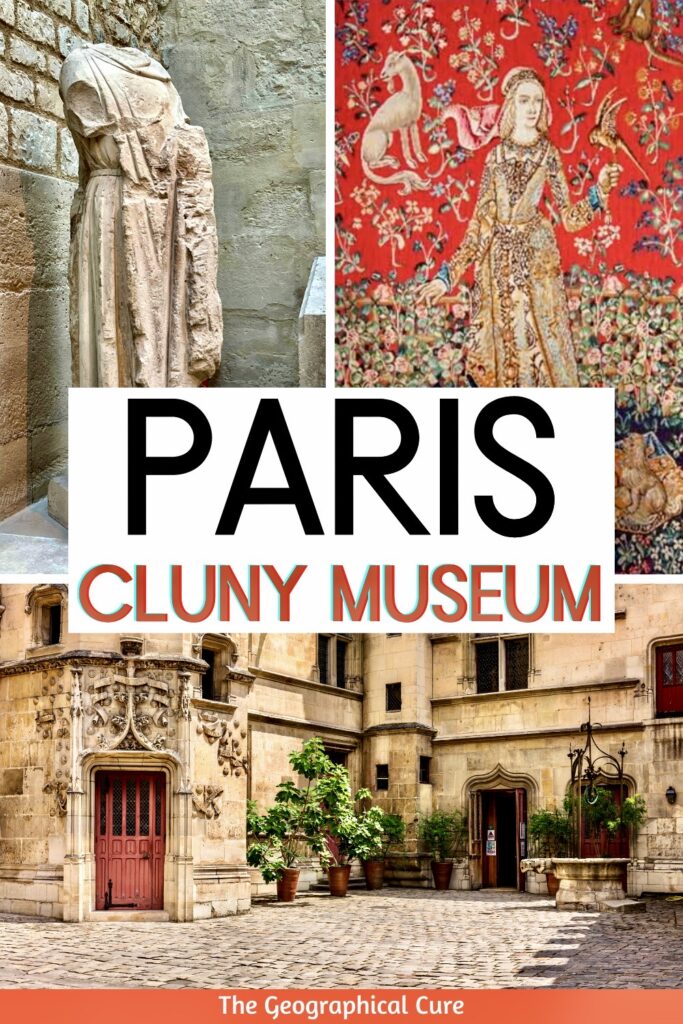Planning a visit to the Latin Quarter in Paris? If so, you should definitely visit the Cluny Museum, also known as the Musée national du Moyen Âge. This is the ultimate visitor’s guide, which tells you everything to see at the Cluny and gives you must know tips for visiting.
The Cluny Museum is housed in one of Paris’ most spectacular medieval mansions, the Hotel de Cluny. It was built on ancient Roman baths, which you can visit.
The museum holds one of the world’s most important collections of medieval art and objects. Among its treasures are the famous Lady of the Unicorn tapestries, the heads of the Kings of Judah from Notre Dame Cathedral, and stained glass windows from Sainte-Chapelle.
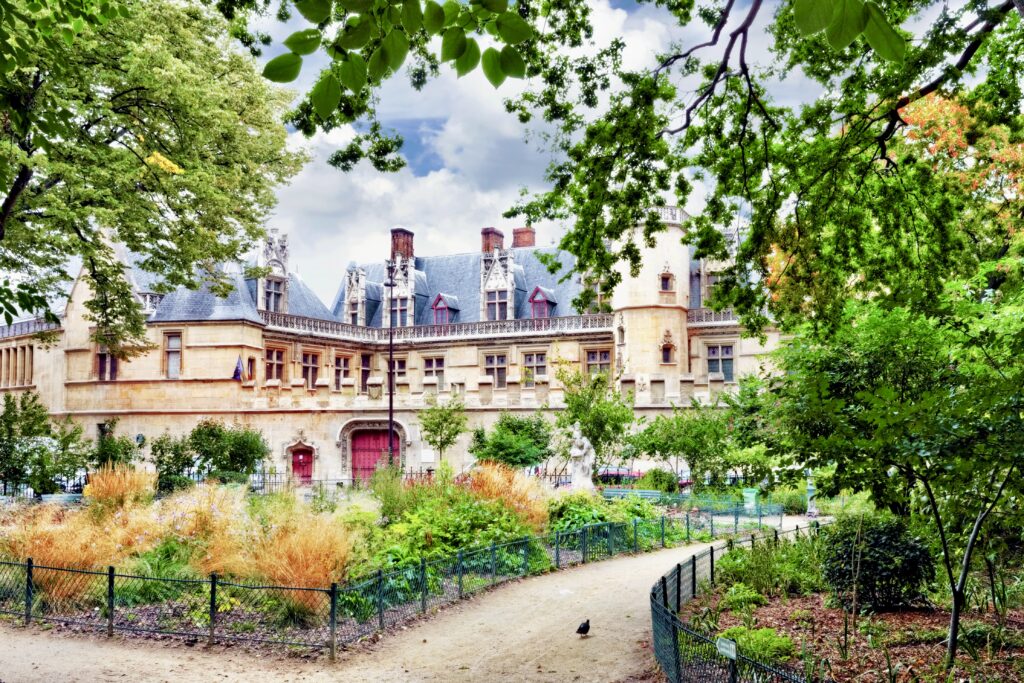
History and Overview of the Museum
The main museum space was acquired and built by the Abbot of Cluny in 1330 and rebuilt in 1510.
The abbot’s Gothic palace was built right on the ancient thermal baths of Lutetia, perhaps to imbue the building with imperial glory. It was one of Paris’ most impressive religious houses, the town residence of the visiting abbots of Cluny.
In 1844, the palace was transformed into a national museum. The museum takes its name from the monks of Cluny.
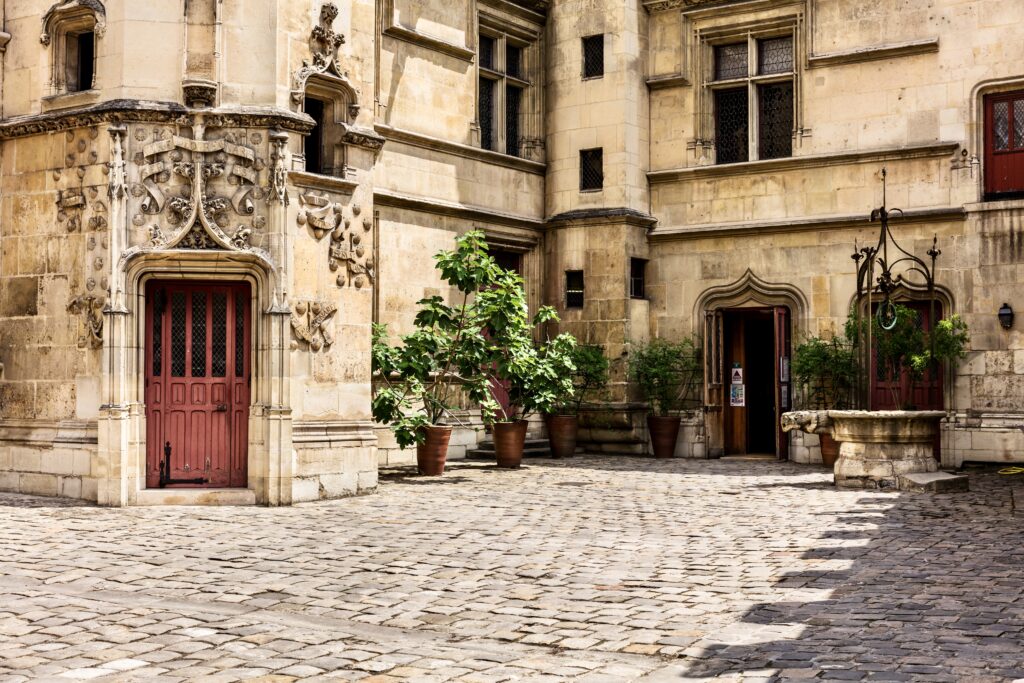
I’ve visited the Cluny before. But, on my last visit to Paris, I wanted to see what changes the recent renovations had brought. Turns out, it’s a lot.
In September 2020, the museum closed for an extensive renovation and modernization project to the tune of € 26 million. Work was completed and the museum reopened in May 2022. The revamp made the museum more accessible and more “readable.”
There is a new reception area on Rue Du Sommerard. Architect Bernard Desmoulin designed a gabled extension clad in bronze-colored aluminum panels and metal mesh. The gables of the new building match the pattern of the ancient elevations.
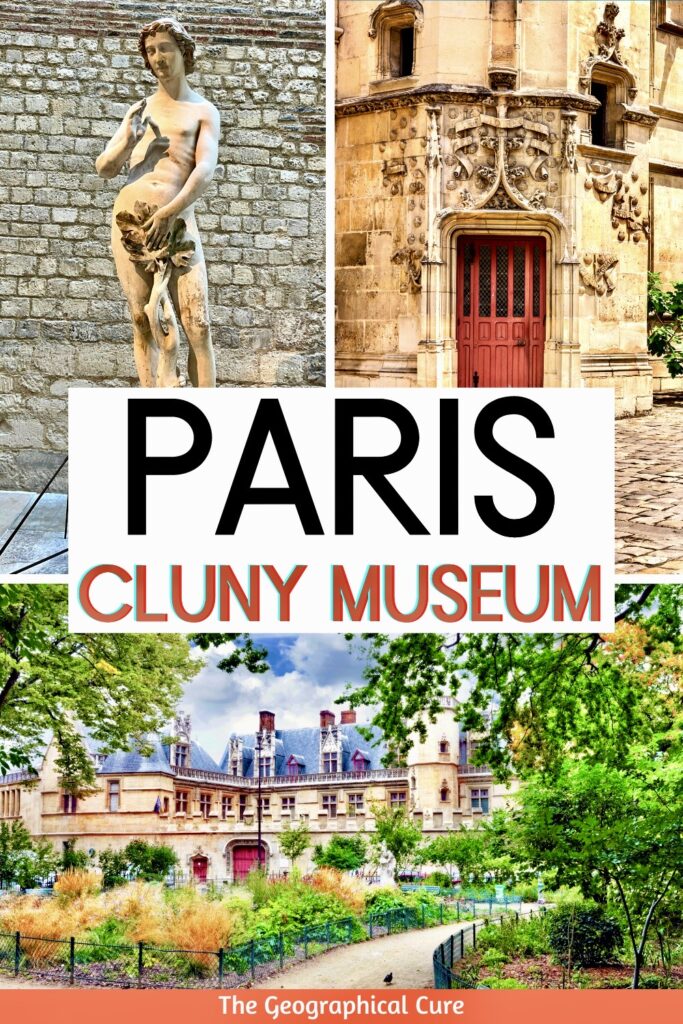
The museum also underwent interior restructuring and has an entirely revamped exhibition layout with brightly lit rooms. The displays are lucid and uncluttered.
Now, 1,600 pieces take you on a chronological (rather than thematic) journey through 21 rooms, from the first vestiges of the 1st century through the 15th century.
Guide to The Cluny Museum: What To See
Objects of extreme rarity and beauty can be seen in every room of the Cluny. The new museum path flows easily from the vaulted Roman baths to the famous Lady and the Unicorn tapestries. Here are the museum highlights that you can’t miss.
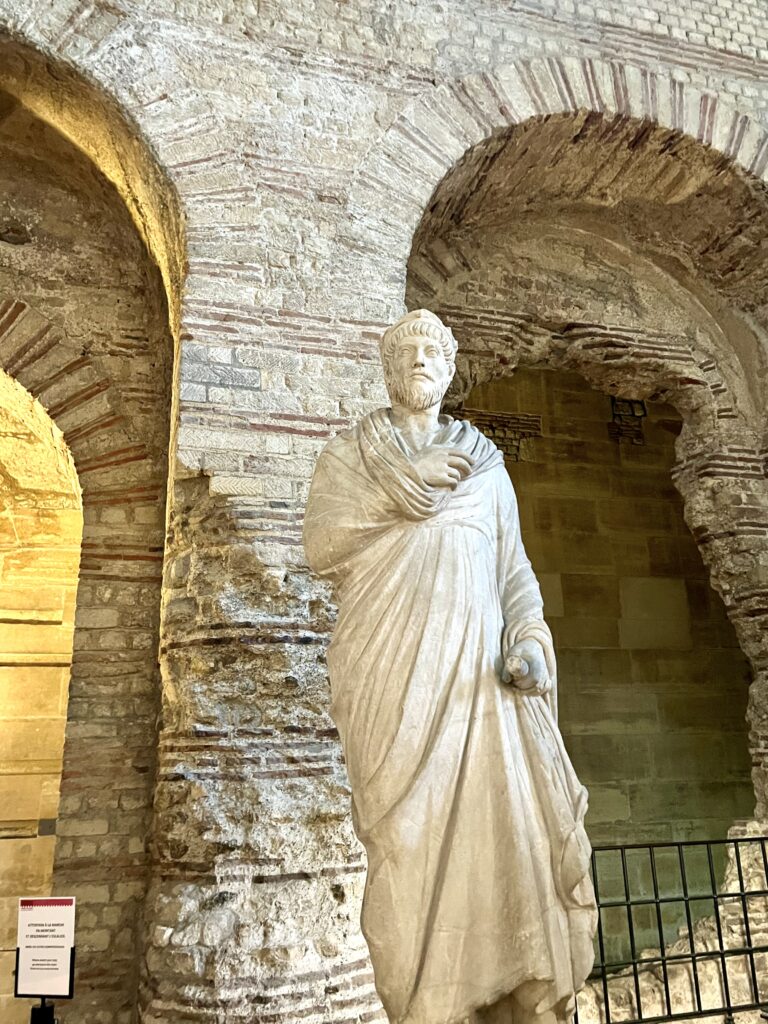
1. The Roman Baths
The Cluny stands on the site of ancient Roman thermal baths. The ruins were part of a massive bath complex dating from the 3rd century AD.
This monumental complex consisted of cold and heated rooms for bathing, a palestrae (outdoor area for physical exercise), and a subterranean infrastructure to keep the baths running smoothly.
Today, a substantial portion of the ancient baths still exists.
The best preserved room is the massive frigidarium (cold room) with intact architectural elements such as Gallo-Roman vaults and fragments of original decorative wall painting and mosaics. It’s a spectacular space with 45 foot high ceilings.
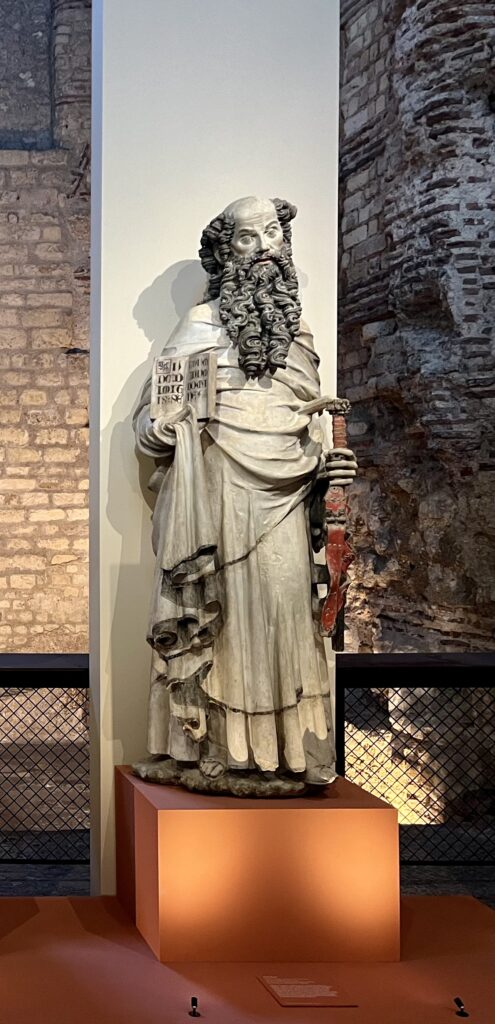
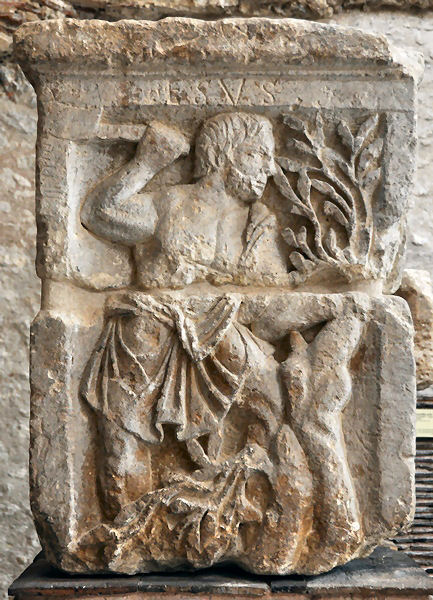
The Frigidarium is used as a venue for temporary exhibitions. When I visited in December 2022, there was a show hosted in collaboration with the Musée des Augustins in Toulouse featuring beautiful 14th century French art.
Be sure to check out the Pillar of the Boatmen, a relief carved out of limestone circa 25 AD.
It’s thought to be the oldest monument in Paris from the Roman age and one of the earliest Gallo-Roman works of art to include inscriptions.
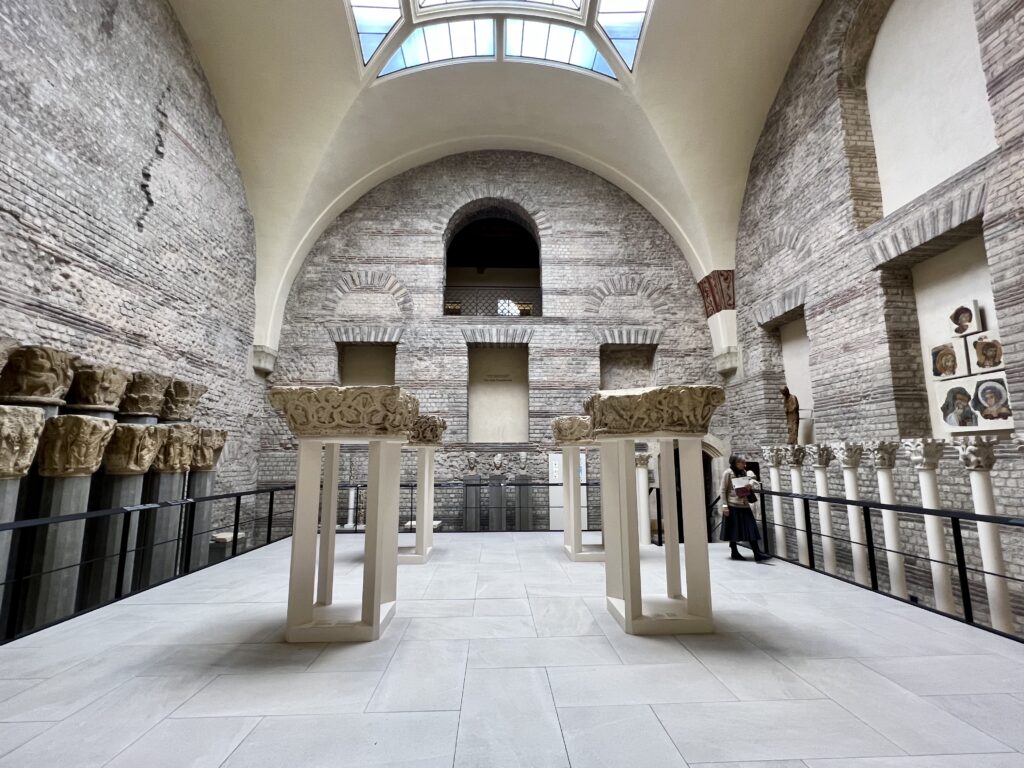
2. Hall 3
This room is between the Romanesque and early Gothic sculpture rooms. The ancient masonry contrasts with the new skylit ceiling.
You’ll find an amazing collection of capitals from various abbeys, including 12 from Saint-Germain-des-Prés that date from 1010-20.
You’ll also see 3 heads of columns representing a prophet, the Queen of Sheba, and Moses.
They were once on the western portals of the Cathedral-Basilica of Saint Denis. The Queen of Sheba, with hair braided and wearing a crown decorated with cabochons, was a fairly recent acquisition in 1986.
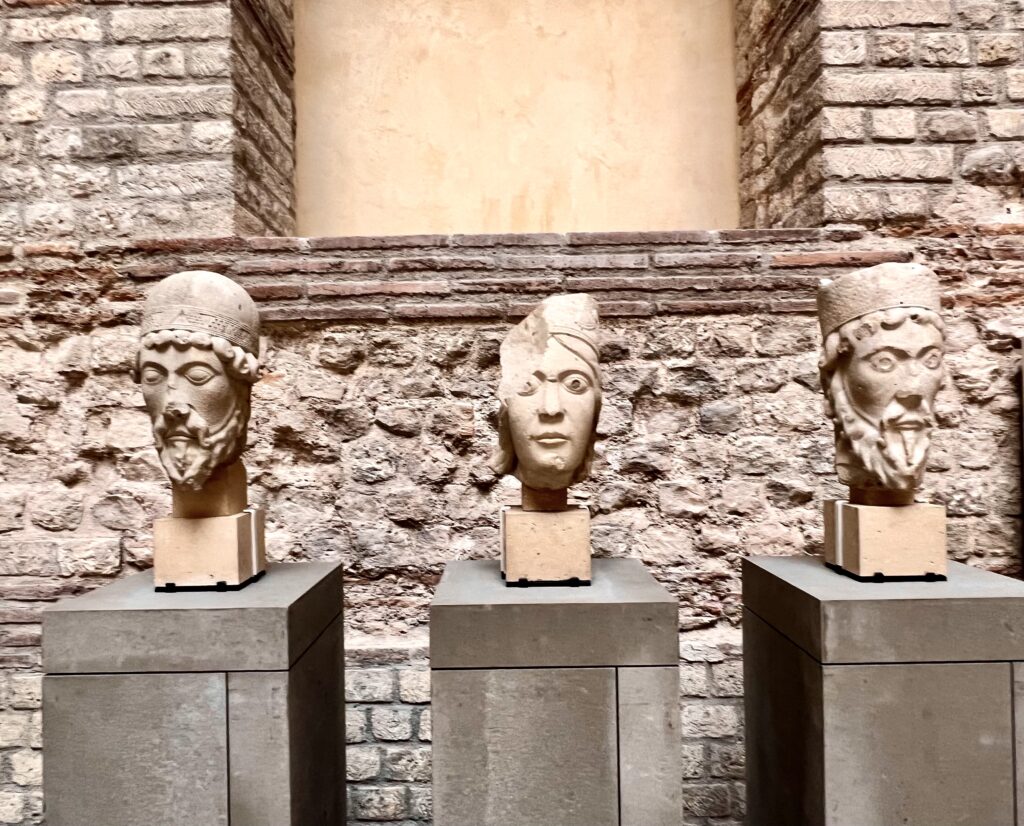
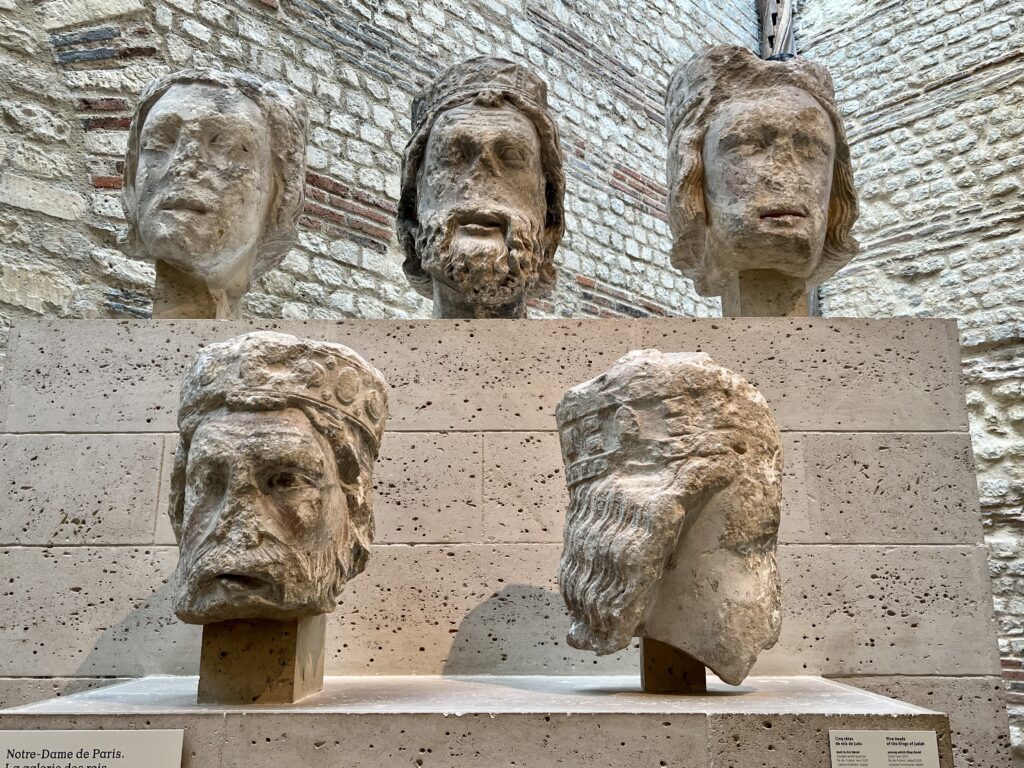
3. Gallery of Kings
Next comes the magnificent room of sculptures from Notre Dame. You’ll find 21 of the 28 stone sculpted heads that once stood upon figures in niches of the cathedral’s western facade. In the 19th century, they were replaced during restorations by Viollet-le-Duc.
The busts most likely represent the kings of Judah, biblical figures considered to be the ancestors of the Virgin Mary. They also symbolize the genealogy of the French kings.
For this reason, during the French Revolution, the heads were violently ripped off and buried in secret. They were only discovered in 1977 lying under the courtyard of the Hotel Moreau.
Some of the faces have faint traces of polychrome. They all were separated from their noses.
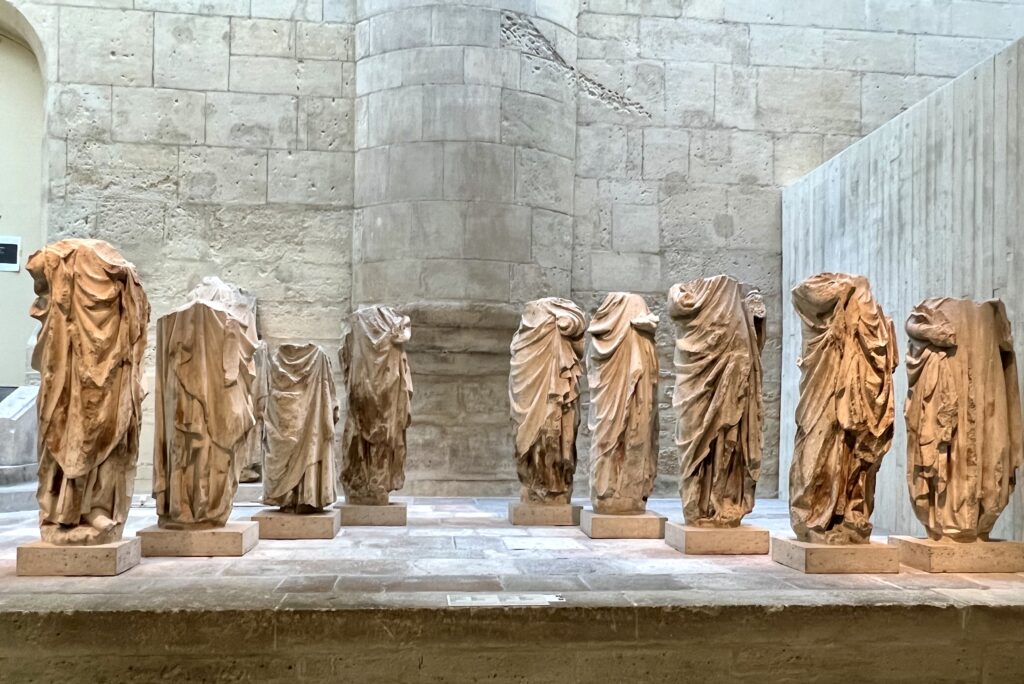
4. Sculptures From Notre Dame
In the same massive room, you’ll find more sculptures corresponding to the heads. They were likewise buried during the French Revolution.
In 1889, 15 sculptures were discovered, holding up the wall of a coal market. The severe and monumental Notre Dame figures were meant to be viewed from ground level at a steep angle.
Touchscreens let visitors make connections between the various fragments of sculpture in the museum and the actual facade of the cathedral.
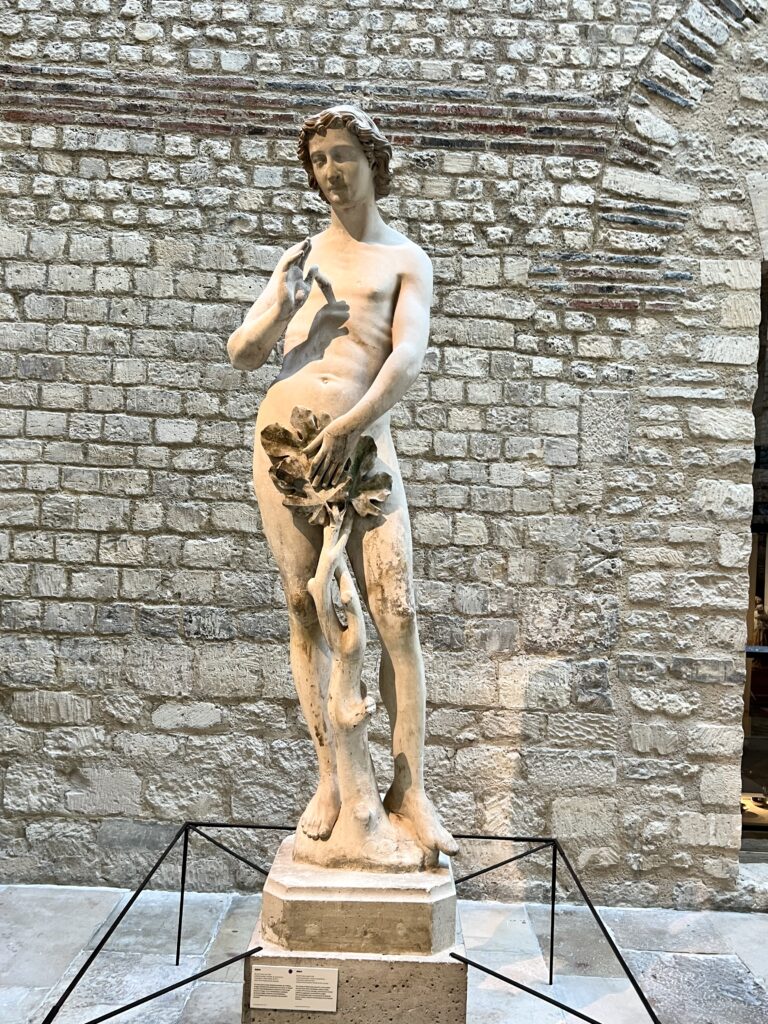
One of the most striking statues is unquestionably the larger-than-life statue of Adam. It was once in a niche on the south facade alongside a statue of Eve (now missing).
It’s a monumental nude, taking its contrapposto posture from classical antiquity. It was carved by Pierre de Montreuil.
The sculpture reminded me of Donatello’s David sculpture in the Bargello Museum in Florence. Donatello, and the Renaissance itself, were likewise inspired by antiquity.
READ: Guide To The Art Works of Donatello
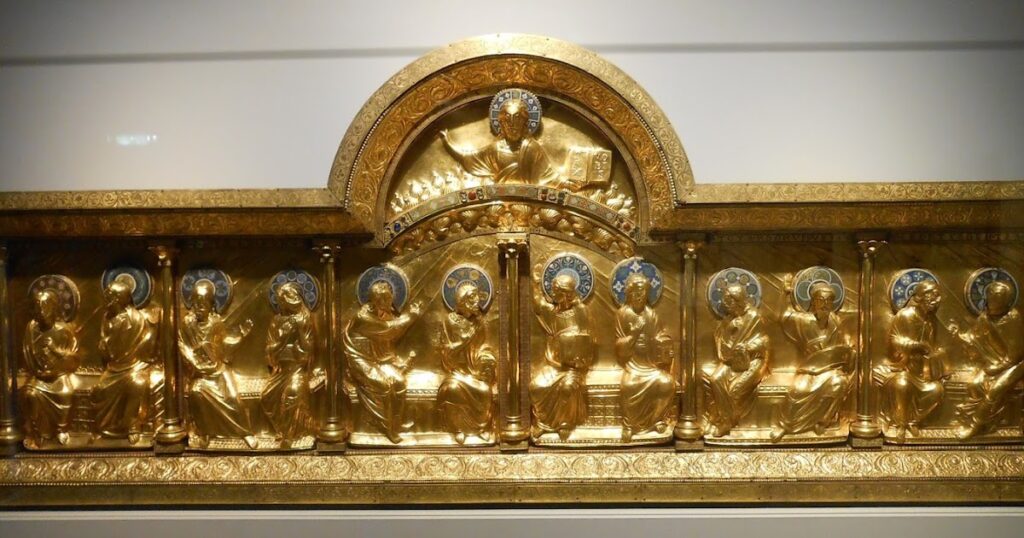
5. Stavelot Altarpiece
Among the many gilded treasures of the Cluny is the Stavelot altarpiece. It’s a retable of gilded copper and enamel from the abbey of Stavelot in Belgium dating from 1160-70.
It shows Christ sending the Holy Spirit to the Twelve Apostles on the day of Pentecost. A blessing Christ appears above the apostles who sit below and receive the rays of light.
The columns represent the seven gifts of the Holy Spirit. The figures in relief were made with the repousse technique, in which the figures are shaped from the back of the metal.
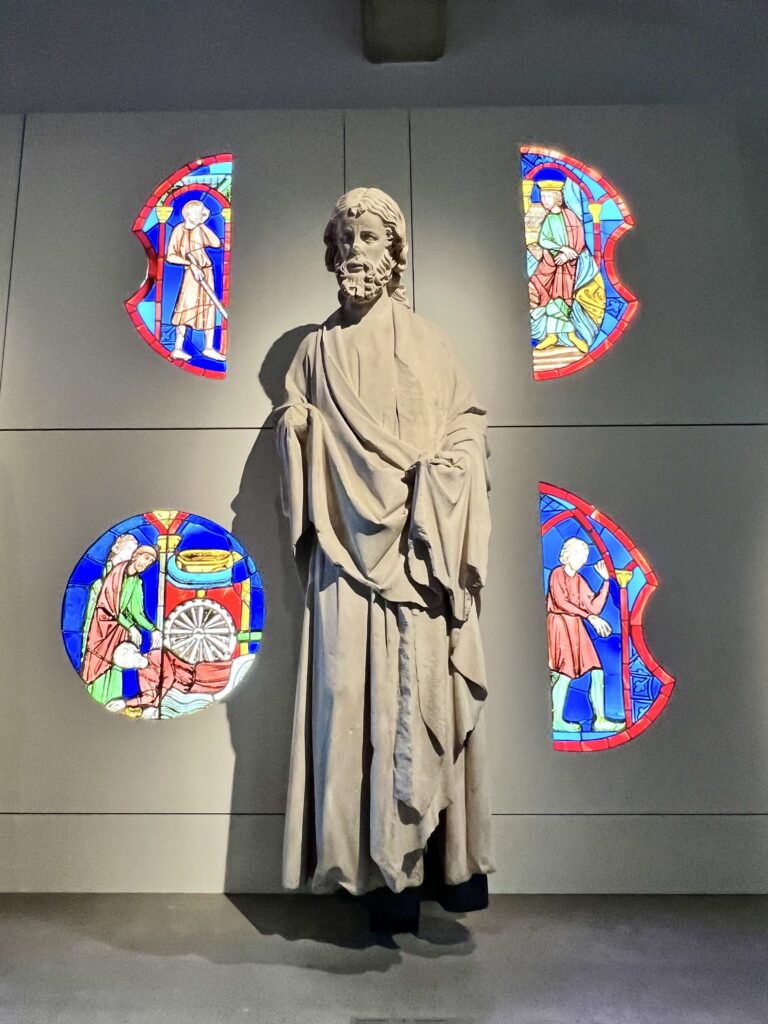
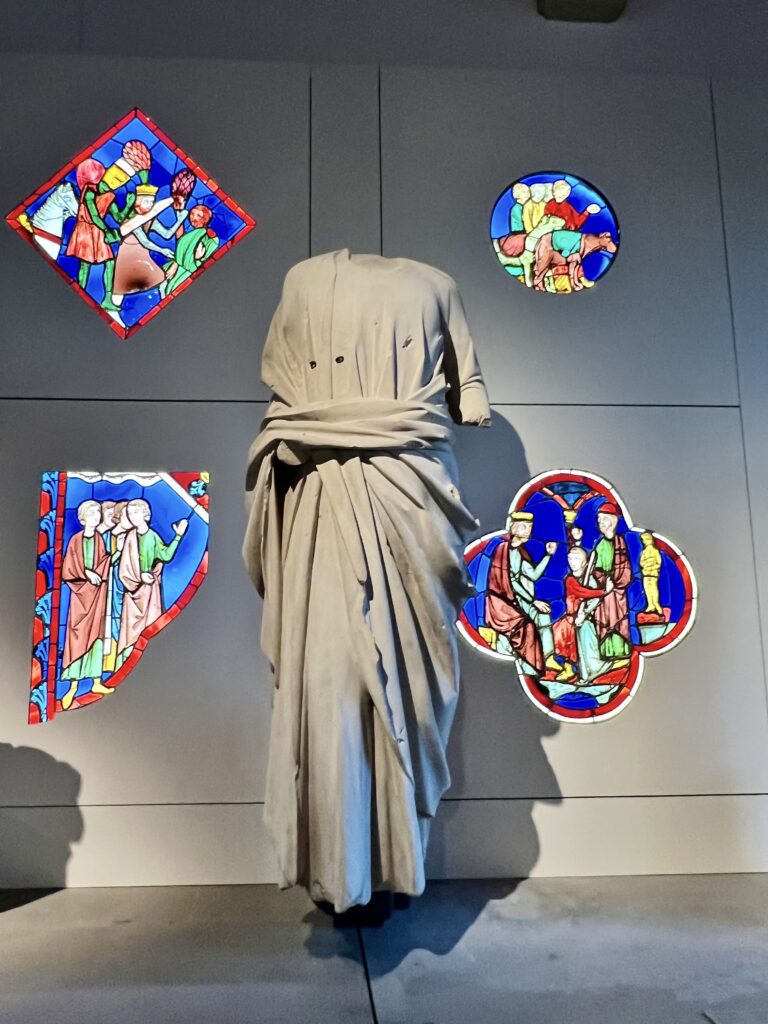
6. Stained Glass From Saint-Chapelle
Sainte-Chapelle is Paris’ finest example of Flamboyant Gothic architecture. Louis IX commissioned the royal chapel to house the Crown of Thorns. The walls are a mosaic of light, covered in 15 tall narrow stained glass windows depicting bible stories.
During the restoration of Sainte-Chapelle in the 19th century, fragments of stained glass that were not preserved were given to the Cluny for display.
The glass is characterized by intense colors and dynamic lines, which are the hallmark of the great 13th century painter-glassmakers in service of the king.
In a new display, the glass is now interspersed with statues of the apostles from Sainte-Chapelle, which date from 1241 to 1248. They once stood on the shafts of columns in each bay.
The statues have all been fully restored. They are displayed on a plinth through which run thin rods, attaching them invisibly to a concrete substructure.
The only identifiable apostle is St. John, known as the Melancholy Saint because of his downcast gaze.
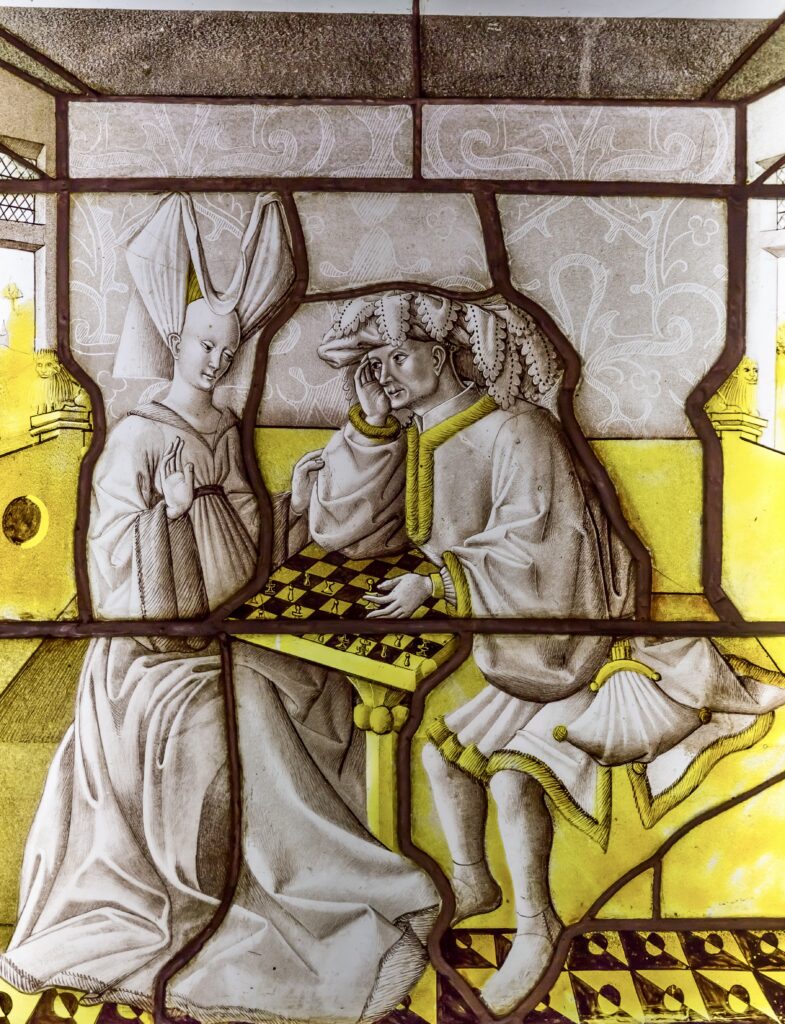
7. Chess Players
This beautiful story-telling panel of stained glass was produced in the 15th century. It comes from the Hôtel de la Bessée in Villefranche-sur-Saône and is shown in the room exploring daily life in the Middle Ages.
The image depicts a game of chess, with a side of romantic sparring. With her raised hand, the lady appears to be feigning surprise at her distracted suitor.
This highly detailed courtly scene was carefully executed, with the techniques of grisaille and silver yellow employed on white glass.
Though very popular among medieval aristocrats, very few examples of civil stained glass remain today, making this a special and delightful treasure.
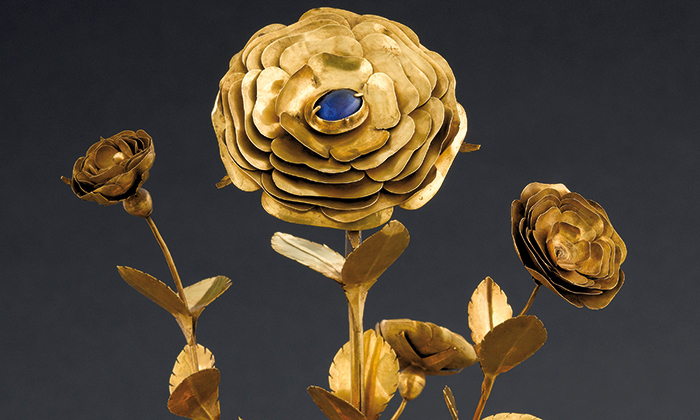
8. Golden Rose
The Golden Rose is a delicate gold ornament, which popes have conferred as a token of reverence or affection to their followers.
The thornless rose was the symbol of the passion of the Christ and his resurrection.
Pope John XXII gave the Cluny rose to the Count of Neuchâtel in 1330. It is the oldest golden rose still held in a museum today. It was created by the Sienna goldsmith Minucchio who worked in Avignon in southern France.
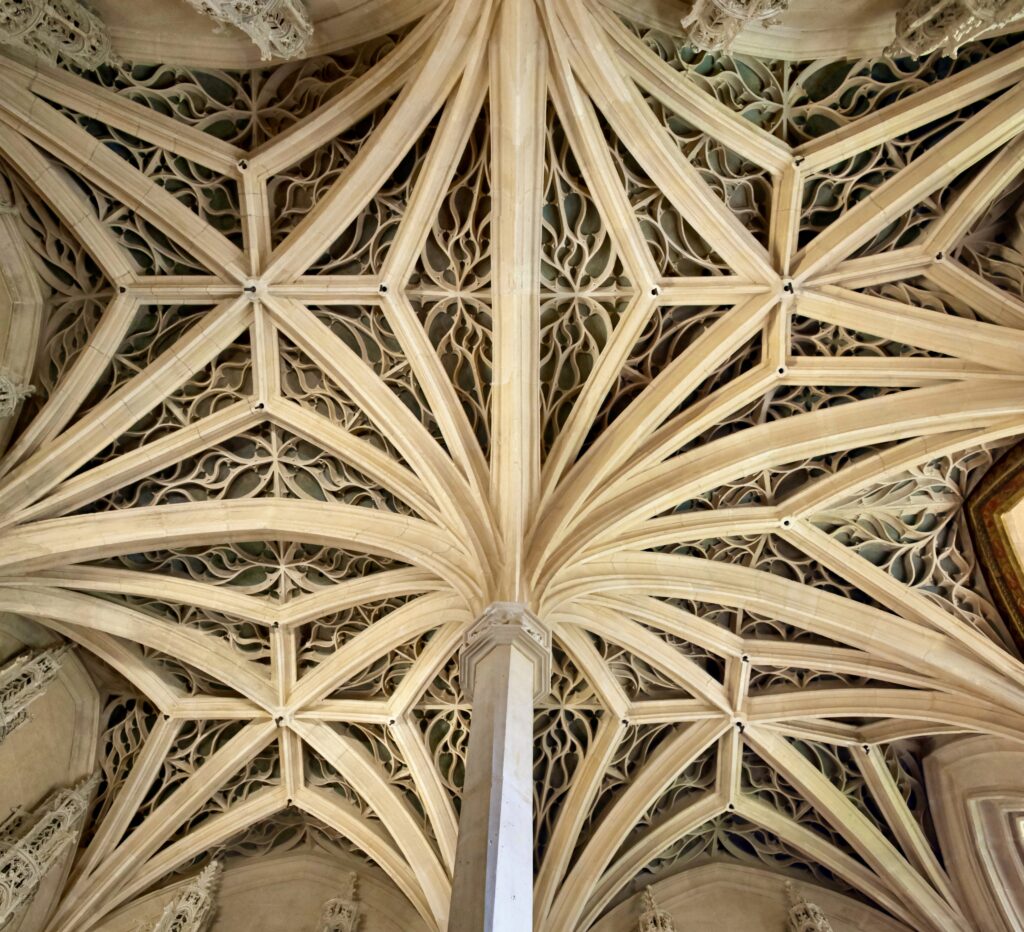
9. Cluny Chapel
The Cluny Chapel is the crown jewel of the medieval mansion and one of its most remarkable elements. It’s a fine example of the Flamboyant Gothic style, with four spectacular ribbed vaults.
The apse is supported by a central pillar. Two angels hold a shield with the arms of Jacques d’Amboise at the top. On either side of the apse are restored mural paintings from 1500.
A beautiful spiral staircase made of stone leads from the chapel to the medieval garden, which is the subject of the next Cluny renovation.
Beginning in 2015, the chapel and its murals were restored.
10. Lady and the Unicorn Tapestries
The famous Lady and the Unicorn tapestries are the grand finale of the Cluny. They are effectively the Mona Lisa of woven art work.
The six exquisite wall hangings are the finest surviving examples from the Middle Ages. After a renovation in 2018, they are hung together in a climate-controlled dark room with special lighting.
Not much is known about the wool and silk tapestries. The artist, although anonymous, is presumed to be French. But they were woven in the Netherlands.
The weaving, done in the late 1400s, features the detailed background pattern of flowers and plants known as millefleur.
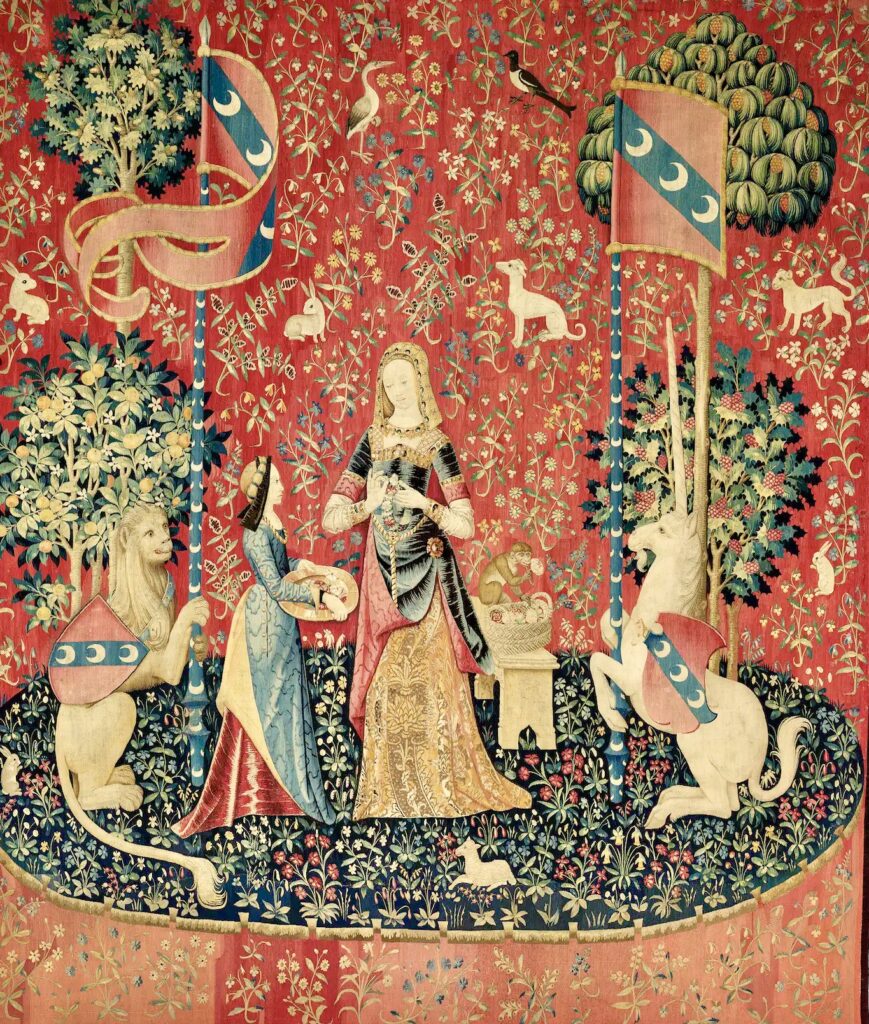
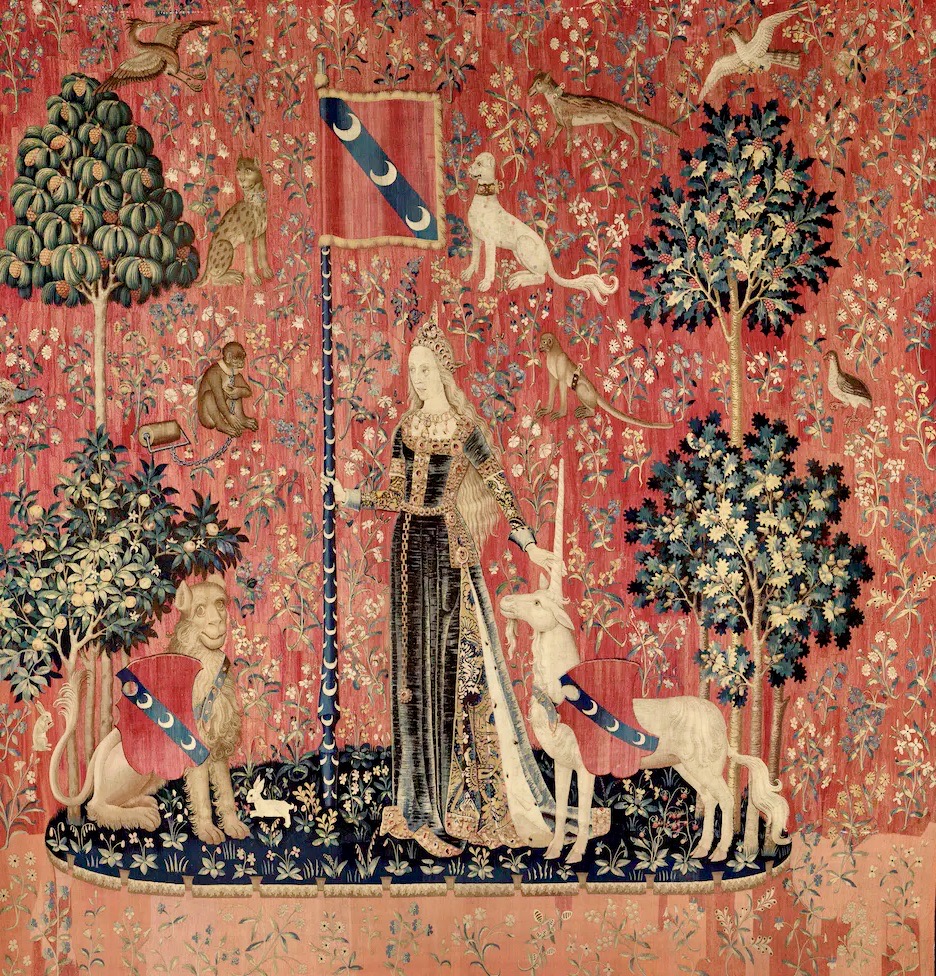
At first, the sponsor’s identity was unknown. But a coat-of-arms appears in all the works, identifying the patron as the Le Viste family. They were nobles who commissioned the tapestries to advertise their power and wealth.
The tapestries depict a romance in which a richly gowned lady is constantly attended by a lion and a unicorn.
The tapestries do not have any male figures and are a testament to women and their beauty, set in an idealized and sensual utopia.
But what is the meaning of these exceptional works? That’s much debated.
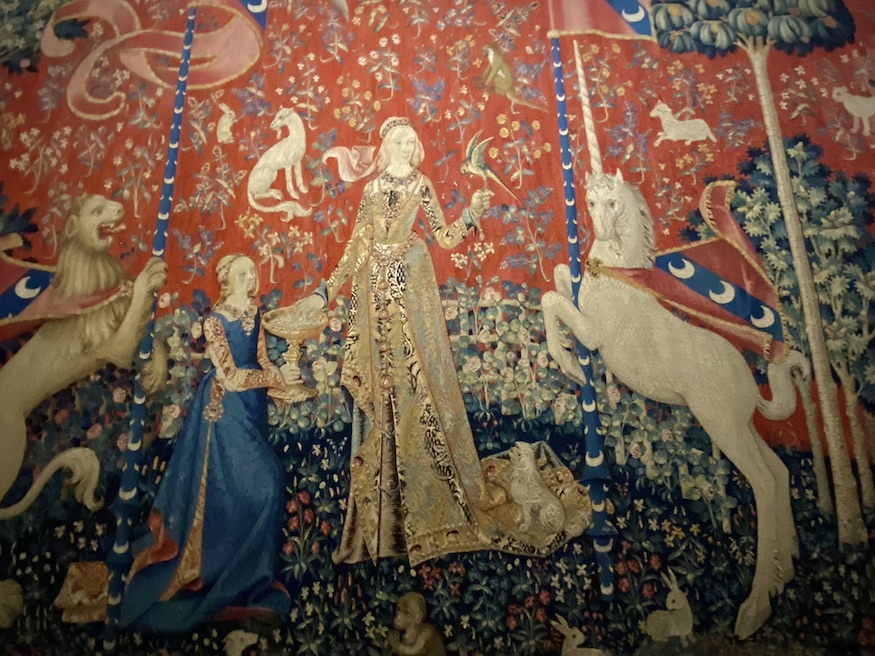
Historians have determined that the first five tapestries are an allegory of the five senses — sight, sound, smell, taste, and touch. But the sixth, and largest tapestry, À Mon Seul Désir (My Only Desire), is more difficult to interpret. The motto is inscribed on a tent.
It may be a celebration of courtly love or marriage. Another hypothesis is that the word “desire” connotes a spiritual aspiration. This is supported by the fact that the lady puts her necklace into a casket, thereby intentionally renouncing passions aroused by the senses.
The gesture likely symbolizes an internal “sixth sense” and the preservation of virtue. This interpretation is also consistent with the presence of the unicorns, which represent chastity or purity.
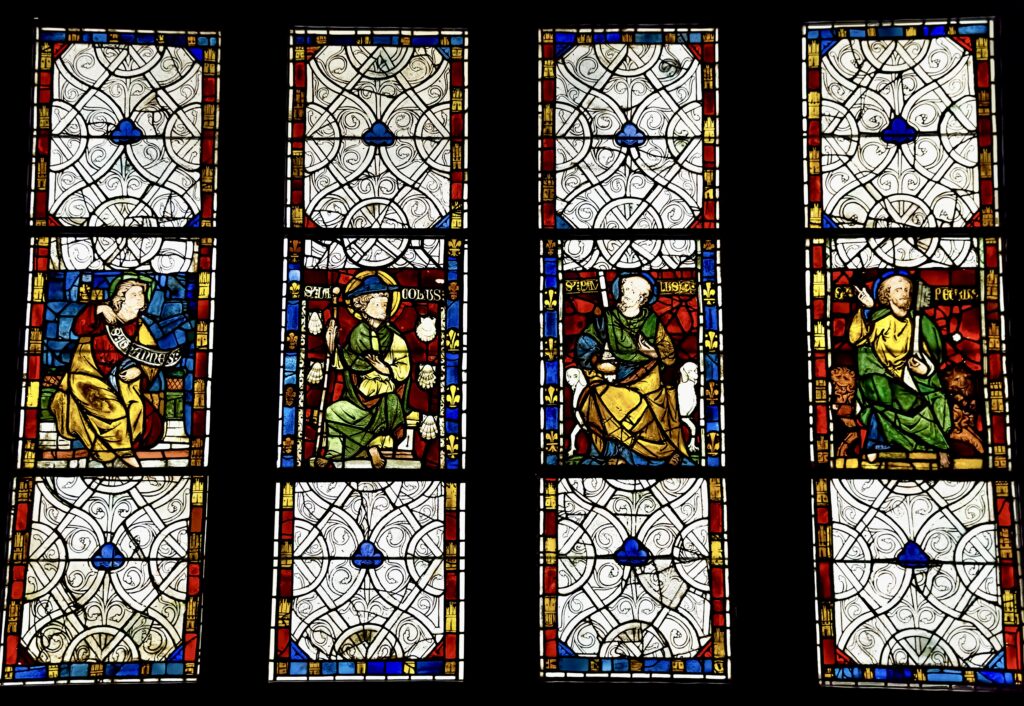
Practical Information & Tips For Visiting The Cluny Museum
No guide to the Cluny is complete without some must know information for visiting.
Address: 28 Rue Du Sommerard. It’s on the corner of the Boulevards Saint-Michel and Saint-Germain, right in the heart of the Latin Quarter.
Metro: Metro: Cluny-La Sorbonne, Odeon, St Michel
Tickets:
Tickets are 12 euros (free for under 18s) and you can buy tickets online here. You also have free entry to the museum with the Paris Museum Pass, which is a great value if you are an avid museum goer.
The audio guide is € 4. But there is so much signage, you may not need it.
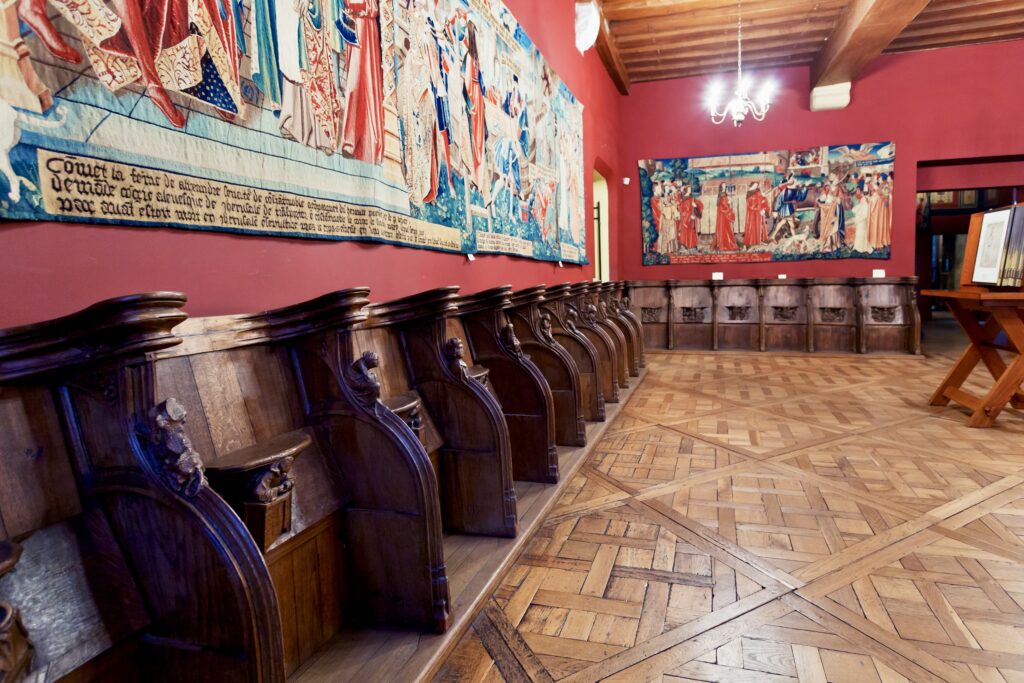
Opening Hours: The Cluny is open Tuesday through Sunday from 9:30 am to 6:15 pm. Rooms start to close at 5:45 pm. On Thursday nights, the museum is open until 9:00 pm.
Tour: You can also visit the Cluny as part of a guided tour of the Latin Quarter.
Lockers: There are free lockers to store your coat and/or bags.
Cafe des Amis: Cafe des Amis is a new cafe in the museum that also opened on May 12, 2022. It’s located in the heart of the visitor route. You can take a gourmet break and nibble on salads and sweet and savory dishes.
I hope you’ve enjoyed my guide to the Cluny Museum. You may enjoy these other Paris travel guides and resources:
- 5 day itinerary for Paris
- 3 day itinerary for Paris
- 2 day itinerary for Paris
- Hidden gems in Paris
- Guide To Montmartre
- Guide To the Latin Quarter
- Guide to the Marais
- Best Museums in Paris
- Louvre Survival Tips
- Guide To the Musee d’Orsay
- Secret Day Trips from Paris
If you plan on visiting the Cluny Museum, pin this guide for later.
